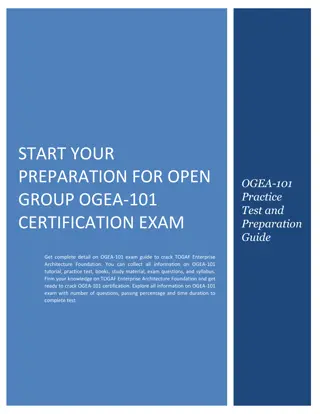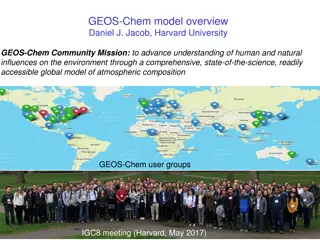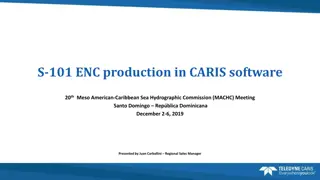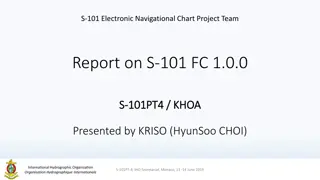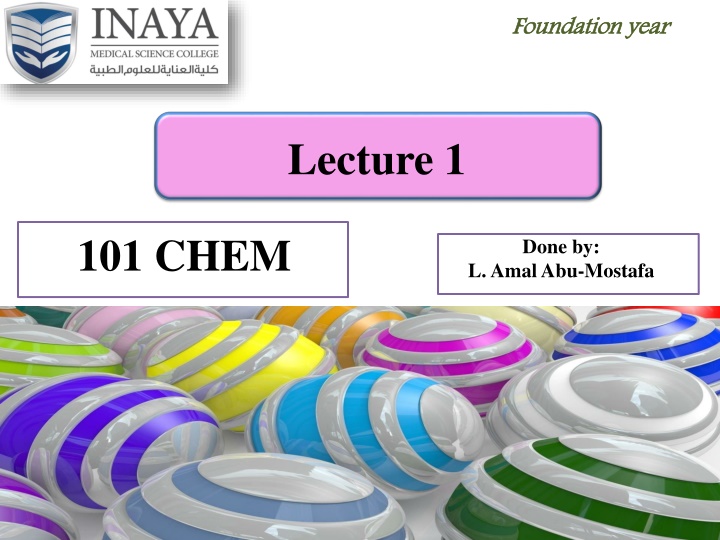
Chemical Laws and Principles: Conservation, Definite Proportions, and More
Explore foundational chemical laws including the law of conservation of mass, law of definite proportions, and examples illustrating these principles. Understand the significance of these laws in chemical reactions and compound formation.
Download Presentation

Please find below an Image/Link to download the presentation.
The content on the website is provided AS IS for your information and personal use only. It may not be sold, licensed, or shared on other websites without obtaining consent from the author. If you encounter any issues during the download, it is possible that the publisher has removed the file from their server.
You are allowed to download the files provided on this website for personal or commercial use, subject to the condition that they are used lawfully. All files are the property of their respective owners.
The content on the website is provided AS IS for your information and personal use only. It may not be sold, licensed, or shared on other websites without obtaining consent from the author.
E N D
Presentation Transcript
Foundation Foundation year year Lecture 1 101 CHEM Done by: L. AmalAbu-Mostafa
Lecture Lecture 1 1 Laws of Chemical Combinations
Session Objectives: Session Objectives: The law of conservation of mass The law of definite proportions The law of multiple proportions The low of combining volumes(Gay Lussac s law of gaseous volumes) Dalton s atomic theory Modern atomic theory Avogadro's hypothesis
law of conservation of mass: Lavoisier (France 1789) states that Mass can neither be created nor destroyed in a chemical reaction . This means that during a chemical reaction the sum of the masses of the reactants and products remain unchanged. Total mass of the products remains equal to the total mass of the reactants. H2+ Cl2 2 HCl 2g 71g 73g
Illustrative Problem 8.4 g of sodium bicarbonate on reaction with 20.0 g of acetic acid (CH3COOH) liberated 4.4 g of carbon dioxide gas into atmosphere. What is the mass of residue left? Solution: sodium bicarbonate (NaHCO3)+ CH3COOH CO2+ m? 8.4 + 20.0 = m + 4.4 m = 24 g It proves the law of conservation of mass.
law of definite proportions: By Joseph Proust (France 1799 ) states that In a chemical compound the elements are always present in a definite proportion by mass . Eg 1: Water ( H2O) always contains two elements (atoms) of hydrogen and one atom oxygen combined together in the same ratio of 2:16 or 1:8 by mass. If 9 g of water is decomposed we get 1 g of hydrogen and 8 g of oxygen.
Ice water H2O 1 : 8 http://images.google.com/images?q=tbn:UghGFKFQ06EC:www.alken-murray.com/river.jpg River water H2O 1 : 8 Sea water H2O 1 : 8 A chemical compound always contains same elements combined together in same proportion of mass.
Example: KCl always contains one atom of K for every one atom of Cl In KCl, potassium and chlorine always have a ratio of 39.09 to 35.45 or 1.1 to 1 by mass.
Law of multiple proportions (John Dalton, England) When the same two elements combine to form more than one compound: the ratios of the mass of one element in the first compound to its mass in the second compound, (as it combines with the same mass of the other element), can always be expressed as ratios of small whole numbers( ex: 1:3 or 2:5).
Example of Law of Multiple Proportions 14:8 14:16 14:24 14:32 14:40 Ratio of oxygen combining with 14 parts of nitrogen 8:16:24:32:40 = 1:2:3:4:5 Two elements combine to or more compounds The mass of one of the elements which combines with fixed mass of the others, bear a simple whole number ratio to one another.
Example: Carbon combines with oxygen to form CO and CO2. The Ratio of O in CO2to O in CO is : CO2 CO 12:32 12:16 The mass of C is fixed so: 32: 16 16 16 2: 1
Practice Problem 1 In the carbon compounds ethane (C2H6) and ethene (C2H4), what is the lowest whole number ratio of H atoms that react with the same number of C atoms? Solution: C2H6 24: 6 24: 4 6 : 4 Divide by 2 to find the lowest whole number ratio of H atoms that react with the same number of C atoms C2H4 3 : 2
Practice Problem 2 Carbon reacts with oxygen to form two compounds as shown: Compound A: 2.41 g C, 3.22 g O. Compound B: 6.71 g C, 17.9 g O. Find the lowest whole number ratio of C that react with an equal mass of O.
Solution Strategy 1. Find the grams of carbon per 1 g of oxygen for each compound. 2. Divide the highest answer by the smallest answer.
Solution Compound A Compound B C : O C : O 2.41: 3.22 6.71 : 17.9 We should fix the mass of O in both compounds 2.41: 3.22 6.71 : 17.9 3.22 3.22 17.9 17.9 0.748: 1 0.375: 1 0.748 : 0.375 0.375 0.375 2 : 1
Home Work Practice Problem 3 Lead forms two compounds with oxygen as shown: Compound A: 2.98 g Pb, 0.461 g O. Compound B: 9.89 g Pb, 0.763 g O. For a given mass of oxygen, what is the lowest whole number mass ratio of lead in the two compounds?
Low of combining volumes(Gay Lussac s law of gaseous volumes) The law of combining volumes states that, when gases react together to form other gases, and all volumes are measured at the same temperature and pressure: The ratio between the volumes of the reactant gases and the products can be expressed in simple whole numbers.
For example, Gay-Lussac found that 2 volume nitrogen oxide 1 volume nitrogen 1 volume oxygen gas nitrogen oxide gas N2 2NO O2 1 : 1 : 2 2 volume hydrogen gas 1 volume oxygen gas 2 volume steam 2H2 2 : 1 : 2 O2 2H2O
Do you know The laws of chemical combinations are based on quantitative results of chemical reactions.
In the last lecture we talked about: The law of conservation of mass. The law of definite proportions. The law of multiple proportions. The low of combining volumes(Gay Lussac s law of gaseous volumes). Now we will solve some Illustrative Problems about the laws:
Illustrative Problem 1: Two samples of a gas were analyzed. One contained 1.2g of carbon and 3.2 g of oxygen. The other contained 27.3 % carbon and 72.7% oxygen. The experimental data are in accordance with 1. Law of conservation of mass 2. Law of definite proportions 3. Law of multiple proportions 4. Low of combining volumes
Solution: Sample 1 Sample 2 1.2g of carbon 27.3 % carbon 3.2 g of oxygen 72.7% oxygen We will calculate the percentage % of C in sample 1 to see if it is the same % of C in sample 2: 100 2 . 3 2 . 1 + 2 . 1 = = 27 3 . % Which is same as in the second sample. Hence law of definite proportion is obeyed.
Illustrative Problem 2: Carbon is found to form two oxides, which contains 42.8% and 27.27% of carbon respectively. Find out which of the laws of chemical combination is proved correct by this data?
Solution: First we should convert the mass percentages in to grams. Suppose that we have a 100 g of each oxide, then: In the first oxide In the second oxide Mass of C = 42.8 g Mass of C = 27.27 g Mass of O = 57.2 g Mass of O = 72.73 g Carbon :Oxygen Carbon : Oxygen 42.8 : 57.2 27.27 : 72.73 We should fix the mass of O: 42.8 : 57.2 27.27 : 72.73 57.2 : 57.2 72.73 : 72.73 0.748 : 1 0.374 : 1 0.748 : 0.374 Divide the highest answer by the smallest answer. 0.748 : 0.374 0.374 0.374 = 2:1
Illustrative Problem 3: Zinc sulphate crystals ZnSO4contain 22.6% of zinc and 43.6% of water. How much Zinc should be used to produce 13.7 g of zinc sulphate crystals and how much water they will contain? (Hint: Law of constant composition) Solution: We should convert the mass percentages into grams, by supposing that the hole compound is a 100g So, 100 g of ZnSO4will contain 43.9 g water and 22.6 g zinc
Solution: First the mass of Zn in 13.7 g ZnSO4 : 100 g of ZnSO4contains 22.6 g of Zn When I have 13.7 g of ZnSO4 ?? g Zn mZn= 22.6 13.7 = 3.0962 g 100 Second, the mass of water in 13.7g ZnSO4: 100 g of ZnSO4contains 43.6 g of H2O When I have 13.7 g of ZnSO4 ?? g H2O mH2O = 43.6 13.7 = 5.9732 g 100
Daltons Atomic Theory: Dalton s atomic theory from about 1803 is the basis of today s chemistry, this theory consists of six parts: 1. Matter is made up of indivisible particles called atoms. 2. Atoms cannot be created or destroyed in a chemical reaction. 3. Atoms of the same element are similar with respect to shape, size and mass.
4. Atoms of different elements have different masses and properties. 5. Atoms combine in small whole number ratios to form compounds. 6. Atoms of two elements may combine in different ratios to form more than one compound. SO2 1:2 S+O2 SO3 1:3
Limitations of Daltons Atomic Theory Later researches proved that Dalton s atomic theory was not wholly correct. 1) Atoms of the same or different types have a strong tendency to combine together to form a new group of atoms . For example, hydrogen, nitrogen, oxygen gases exist in nature as group of two atoms . This indicates that the smallest unit capable of independent existence is not an atom, but a group of atoms .
Limitations of Daltons Atomic Theory So it didn t explain causes of chemical combination and law of combining volume 2) With the discovery of sub-atomic particles, e.g., electrons, neutrons and protons, the atom can no longer be considered indivisible. 3) Discovery of isotopes indicated that all atoms of the same element are not perfectly identical. At least, they differ in their masses. Atoms of the same element having different masses are called isotopes.
Ex: carbon (atomic mass = 12.011) Carbon (14) and carbon (12) exist in nature 4) It does not give idea about structure of atom
Modern atomic theory 1. Atom is divisible 2. Same atom may have different atomic masses like 1H, 2H and 3H. 3. Different atoms may have same atomic mass like 40Ca and 40Ar. 4. Atom is the smallest particle that takes part in a chemical reaction. 5. The mass of an atom can be changed into energy.
Avogadro's hypothesis: The law is named after Amedeo Avogadro (Italy 1811): It is a gas law which states that, under the same condition of temperature and pressure equal volumes of all gases contain the same number of molecules. Thus, the number of molecules or atoms in a specific volume of ideal gas is independent of their size or the molar mass of the gas.
Examples: As an example, equal volumes of molecular hydrogen and nitrogen contain the same number of molecules when they are at the same temperature and pressure, and observe ideal gas behavior. Another example: Hydrogen + Chlorine Hydrogen Chloride 1 molecule 1 molecule 2 molecules 2 atoms 2 atoms 4 compound-atoms
Exercise - 1 Percentage of copper and oxygen in samples of CuO obtained by different methods were found to be the same. This proves the law of (a) constant proportions of mass (c) multiple proportions (b) conservation (d) none of these
Exercise - 2 A balanced chemical equation is in accordance with (a) law of definite proportions (b) Avogadro s law (c) Gay Lussac s law (d) law of conservation of mass
Exercise - 3 Different samples of water were found to contain hydrogen and oxygen in the approximate ratio of 1 : 8. This shows the law of (a) multiple proportion (b) constant proportion (c) reciprocal proportion (d) none of these


